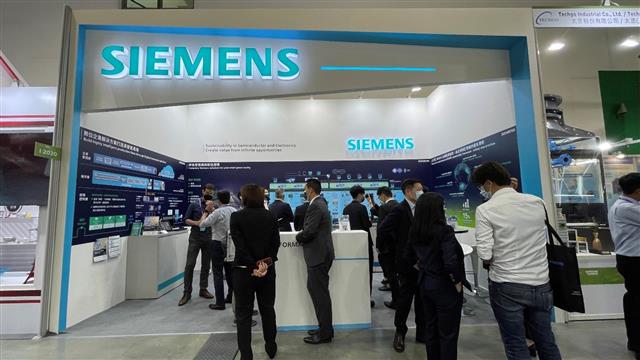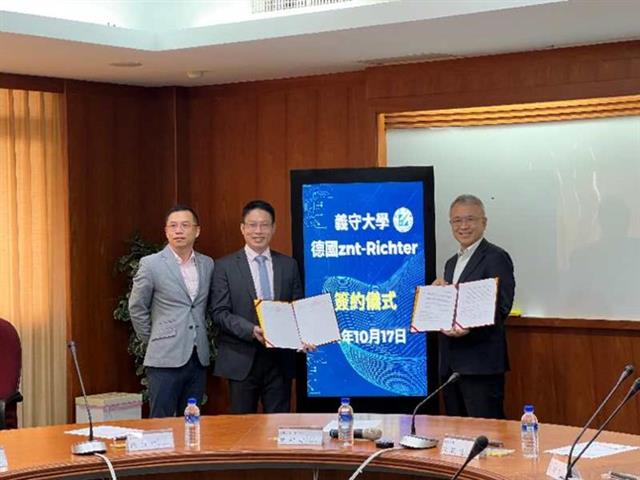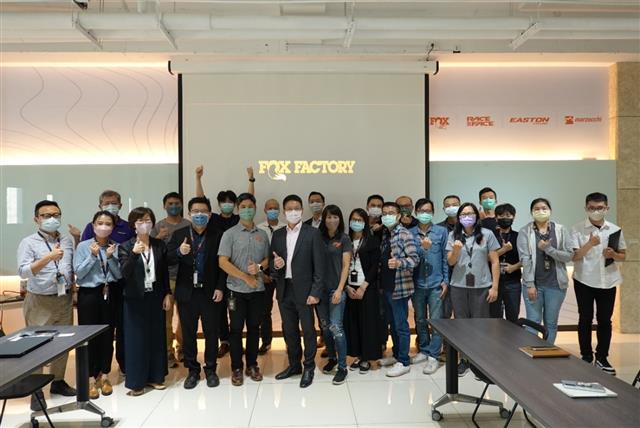Nowadays, information technology and manufacturing are intimately linked to one another. It is inevitable for businesses to upgrade and digitalize in order to remain competitive in the industry. As an industrial automation integration solution supplier, znt-Richter (ZNT) has completed digital transformation for all customers in time, in budget and in quality, and will continue to progress and provide businesses innovative solutions and professional services. In this CEO interview, ZNT shared their experiences in digitalization, opportunities and challenges of digital empowerment, as well as their vision and planning for the industry.

ZNT CEO Bernhard Marsoner

Aaron Chou, ZNT's general manager of Greater China
Q: As an industry-leading supplier of equipment automation platform solutions for realizing Industry 4.0, ZNT has accumulated lots of practical experience in providing innovative software solutions that enables smart manufacturing. Would you share your company's recent development status?
A: Since 1985, we have been providing solutions to the manufacturing industry. Especially in recent years, our business model has experienced a rapid change in many ways. ZNT originally started with equipment automation solutions, primarily for the semiconductor industry. Later on, to fulfill Industry 4.0 demands, initially, we focused mainly on the Manufacturing Execution Systems (MES). Then, we extended horizontally to the entire Manufacturing Operations Management (MOM) solutions and the Advanced Planning and Scheduling (APS) product. Furthermore, we made a vertical extension to the Product Lifecycle Management (PLM) field as well.
In the beginning, we targeted the semiconductor industry with many companies operating disconnected manufacturing systems. Through data integration and equipment automation, we reduced manual and paper-based work in the manufacturing process, integrated disconnected systems and thus helped to implement smart manufacturing solutions. Meanwhile, many other industries have been facing the same manufacturing challenges and, therefore, we broaden our focus to industries such as high-tech electronics, medical device, and lately, batteries.
With the expansion of our product portfolio and target industries, ZNT has been growing continuously and now operates eight offices globally. Four of them are in Asia and the newest one is in Taiwan. Our growing manpower enables us to support global accounts with their digital transformation and execute more and more multi-site cross regional factory rollouts.
Q: ZNT has been focusing on businesses in the semiconductor and high-tech electronics fields and is committed to helping customers to solve production pain points and enhance the real value of production. Would you explain ZNT's achievements in such industries as well as the value ZNT can provide for production optimization based on its industry experience?
A: Without doubt, ZNT had a strong influence on software development for equipment automation in the semiconductor industry in the last 40 years and released one of the leading integration platforms - Process Automation Controller (PAC). Our PAC helped many enterprises to optimize their production processes with data integration, equipment automation and an overall more effective use of their manufacturing resources.
We haven't only cooperated closely with many well-known semiconductor manufacturers in the world consistently but assisted enterprises in transforming their factories and reaching the next level of production. While cooperating with a well-known semiconductor packaging company, ZNT helped the company to establish a comprehensive and transparent smart manufacturing platform based on Siemens Opcenter Execution MES and our PAC. With such systems in place, the speed for new product introduction (NPI) was significantly increased, and the production quality and cost control were greatly improved.
In the high-tech electronics industry, we helped a business to integrate manufacturing silos and disconnected systems by implementing an end-to-end solution starting from design to engineering to manufacturing. In this case, we offered the Valor solution, which improves the NPI process, optimizes manufacturing processes, and increases the overall equipment efficiency (OEE) of several SMT-lines and which is also part of the Siemens Digital Software portfolio. These are good examples of how we provide feasible solutions as well as a digital strategy enabling customers to transform their business and reach the next level.
Q: Could you share your idea of the opportunities and challenges that domestic manufacturers are facing? How could increasing the level of industrial automation and accelerating the transformation into smart manufacturing make businesses more competitive in the market?
A: As most countries in the world have lifted their COVID restrictions, we are now moving into the "post pandemic era." Lately, Taiwan's manufacturing industry has stepped out of the dark cloud brought by the pandemic and appears to have a strong growth potential. In order to support digital transformation, the government has launched the "Digital Government Program." One of the objectives is to promote the digitalization and automation of the industry to achieve a higher manufacturing level.
Working on digitalization is the essence to stay competitive after businesses experienced the massive changes caused by the pandemic. Especially in regulated manufacturing industries such as medical devices, automotive, and aerospace, manufacturers have to speed up their NPI while meeting higher quality standards and zero-defect requirements as well as traceability demands. Enterprises realize that traditional paper-based production and disconnected manufacturing systems make regulatory audits and shopfloor tracking a nightmare. Therefore, digitalization and automation, have been widely embraced as an opportunity in order to increase the traceability and transform the manufacturing process.
An efficient short-term solution is to implement the MES to eliminate the paper-based documentation. This leads to a significant effect on reducing scrap materials and enhancing manufacturing efficiency and cost control. Even though implementing MES brings about visible results within a short amount of time, companies have to continue their investments to fully integrate all their manufacturing systems and data.
To achieve a successful transformation, companies have to look at a holistic digitalization strategy to have an integrated view of the entire manufacturing lifecycle. Selecting a solution provider that offers an integrated manufacturing solution and matches the business's digitalization strategy is the most effective approach. A future-proof software environment for supporting smart design and manufacturing process covers equipment automation, quality control, and performance analysis and consists of PLM, simulation, and MOM products that are fully integrated. Such a solution platform provides a basis for further transformation and enables companies to keep up with any market demands. The important note is that transformation does not have to be done all at once but can be implemented step by step while always keeping the overall goal in mind.
Q: The pandemic has driven many manufacturing enterprises to accelerate the pace of digital transformation. Based on the ZNT's practical experience, what would you say about the meaning of "digital transformation" to enterprises? How should enterprises cope with the transformation in the post-pandemic era?
A: When it comes to digital transformation, we must not forget to mention the concepts of digital thread and digital twin which together set the ultimate goal of digital transformation. Digital thread means forming a closed loop from product design to shop floor manufacturing, so that all production line information can be monitored in real time, and adjustments can be made timely. By fully integrating any relevant system in the manufacturing process, we can achieve the digital thread of all production processes and information. Digital twin, on the other hand, means simulating the entire manufacturing process in a virtual environment, from designing the layout to visualizing material flows and possible bottlenecks to simulating the programmable logic controller (PLC) code for the automation hardware. In this way, manufacturers can test and optimize new production lines through simulations, thereby reducing the time, effort, and risk of actual debugging. This helps the manufacturing industry to improve quality management and efficiency, reduce production costs, enhance enterprise competitiveness, and take environmental protection and sustainable operation into account. Both digital thread and digital twin, specifically the digital twin of production are supported by our PAC equipment automation solution which collects and processes machine data.
The pandemic has indeed catalyzed the digital transformation in the entire industry and many enterprises have begun to study or carry out the transformation work. Same as the businesses, we expect to see short-time results, but our advice to them is to have a clear focus on a mid-term digitalization roadmap. Therefore, the Return on investment (ROI) and Total Cost of Ownership (TCO) should be measured on mid-term results. Throughout the transformation process, enterprises should have a detailed performance overview of their current manufacturing system and the state of their resources, replace disconnected systems with an integrated system, and work towards the transformation goal. As one of the pioneers of digitalizing IT processes, we always focus on the overall picture rather than stand-alone solutions.
Q: The idea of sustainable business operation is very popular among Taiwan's manufacturers recently. Could you share the relevant solutions that ZNT can provide? What kind of assistance could you offer enterprises concerned about this issue?
A: Regarding sustainable business operation, we are fully aware of the attention paid to this issue by the government officials, businesses, and academia. In September, we participated in the "Advanced deployment of green supply chain, has smart carbon reduction kept up?" held by Midat. In the seminar, we shared how ZNT applied Siemens Teamcenter PLM and Opcenter MES to meet customers' needs. In addition to functions such as product carbon footprint disclosure, profitability analysis, tool cost and product cost accounting, Teamcenter platform also has a complete carbon dioxide equivalent computing architecture, enabling users to view relevant data on the operation page from the initial product design stage to the manufacturing process. On the other hand, Opcenter collects data and monitors production materials in all stages of the manufacturing process, which can help the manufacturing industry to go paperless and reduce carbon emissions. The integration of the two solutions supports enterprises to reach the long-term goal of green sustainable operations.
Besides green manufacturing processes, environmental protection and sustainable business operation require an orderly and strategic sustainable development plan. Talking about manufacturing processes, outdated and disconnected systems thus need to be eliminated gradually following the transformation blueprint. Again: a holistic digitalization strategy including concepts like digital twin and closed loop manufacturing strongly support transformation processes. It enables enterprises to reduce material usage, increase manufacturing efficiency and therefore minimize their environmental footprint while strengthening their market position.
Q: ZNT has been providing software related technical services to Taiwan's customers for many years. After setting up a branch in Taiwan this year, what would the plans for ZNT to further develop Taiwan's manufacturing market be?
A: Starting 1985, ZNT has been providing innovative software solutions and professional services for manufacturers in Asia. The feedback we get from our customers clearly shows that they value our approach in facilitating digitalization, optimization and automation. Our enablement approach is highly appreciated and key for maintaining close partnerships with our customers all over Asia including Taiwan. Our new branch in Taiwan enables us to offer local customers more immediate assistance and build an even more solid relationship with them.
In addition to the seminar I already mentioned, several more events took place in the past few months. Together with Siemens Industry Software Co., our global strategic partner, we participated in the 2022 SEMICON Taiwan. During the exhibition, we had meaningful conversations with people from the semiconductor and other industries and learned about their pain points and challenges on their roadmap to smart manufacturing.

2022 SEMICON Taiwan
Photo: ZNT
In mid-October, we signed an industry-academia partnership with I-Shou University (ISU) and donated them Siemens MES and APS software. In addition, our senior consultants who have years of experience in the industry will offer a series of related courses to professors and students at ISU, aiming to nurture more talents in the smart manufacturing field.

MOU signing ceremony at I-Shou University
Photo: ZNT
Moreover, a project with Fox Factory Switzerland GmbH, Taiwan Branch (Fox Factory), a vehicle parts manufacturing company, has kicked off at their factory in Taichung a few weeks ago. By establishing ZNT Taiwan, we are looking forward to expanding our market in the manufacturing industry in Taiwan. Recognizing the urgent demands of digital transformation, we are well prepared to provide customers professional solutions.

ZNT & Fox Factory project kickoff meeting
Photo: ZNT
